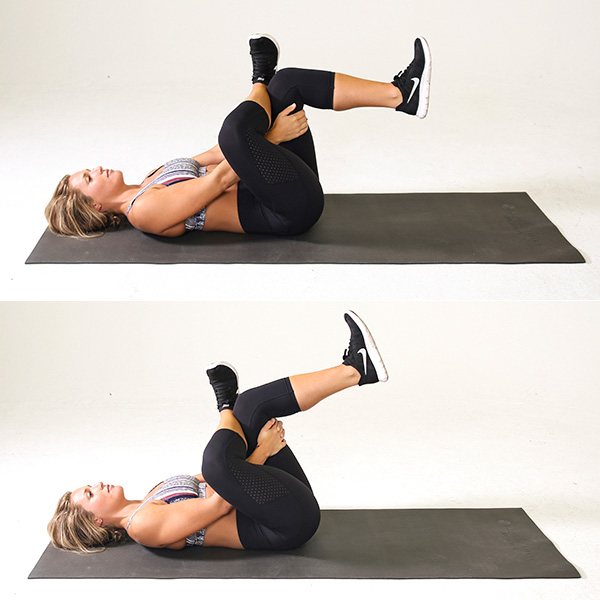Experts Share Top Six Stretches To Do First Thing In The Morning

Including some stretching in your daily morning routine can help energize you for the day.At a time when many of us are sitting more than usual and (rightfully and responsibly) going out less, it makes sense that we’re feeling stiffer and less limber.
Sitting all day, whether at a desk, on the couch or at the kitchen table, has serious consequences for our physical health.Isabella Sprague, a sports physical therapist at Massachusetts General Hospital, told HuffPost that she is seeing a large increase in back, neck and hip injuries due to people sitting more and moving less. Sprague said:
“People are sitting in all kinds of crazy positions just because they have to adapt to these new work-from-home scenarios. We’re seeing a lot of postural-driven injuries that we used to not see as much of.”
Starting the day, especially during the pandemic, with a few stretches is an ideal way to relieve stress and reduce sitting-induced pains that many people are all too familiar with.
“Consistent stretching offers a laundry list of benefits. This includes increased performance, faster recovery, stress relief and pain relief,” said Jeff Brannigan, program director at Stretch*d, an assisted stretching studio based in New York.
“When you are at a certain level of inflexibility, you’ll be prone to all sorts of musculoskeletal problems — things you may not even think would be associated with stretching like cramping, nerve pain and spasms.”
Below, experts share the best stretches to do as soon as your alarm goes off in the morning:
Start your day with an open-book stretch.
Sprague tells her patients to start their day with an open-book stretch, which opens up the spine and the front of the shoulders while also increasing spinal mobility. This is especially useful before a day of hunched-over typing, texting or sitting.
“For this stretch, you would lie on one of your sides — you can do this in bed — and bend both of your knees up so they’re at about 90 degrees,” Sprague said.
“You then bring both of your arms straight out in front of you on the bed, open up the top arm and twist your upper body away from your bottom arm while looking toward your hand. It’s basically an upper spinal twist. You hold it for a couple seconds and come back to a neutral position.”
She added that an open-book stretch should be repeated on both the left and right sides of the body.
Stretch your arms up above your head.
Stretching helps keep us mobile, especially since our tissue tightens after long periods of staying still or lying down, according to Kelly Roberts Lane, owner of Fix It Physical Therapy in Minnesota. She recommends doing a fairly simple stretch in the morning that is often done at the end of tough spin classes or high-intensity interval training workouts. Roberts Lane said:
“Reach your arms all the way over your head and look up. Then, roll your spine down one vertebra at a time until you are touching your toes or are as close to them as you can get. Let your head hang. Straighten one knee and then the other to get a deeper hamstring stretch.”
It’s important to hang in this position for a few moments, then roll back up and repeat this full stretch three times, she added.
SEE ALSO: Why Sitting Down For Six Hours At A Stretch Could Harm A Pregnant Woman
Try a seated stretch ideal for combating back pain.
Two of the most important areas to address in the morning are the back and neck due to harmful sleeping positions, Brannigan said.
“It’s very easy to have the spine off-kilter when sleeping in a side-lying position if you’re not using a proper pillow — while sleeping face down can put tremendous stress into the lumbar spine as it compresses the lower back,”
he said.
To help with back pain, Brannigan recommends Stretch*d’s Twist & Dipp*r stretch, a seated movement where you put your hands behind your head, twist your torso as far as you can in one direction and then drop your elbow toward your knee. This stretch should be held for two seconds and repeated 10 times on each side.
Brannigan added that this stretch targets the quadratus lumborum, a deep abdominal muscle that is often responsible for back pain.

Stretch your neck, which gets tense after a night of sleep.
One of Brannigan’s favorite stretches in the morning is the Maybe movement, a simple stretch that focuses on the neck.
To do this, put your arm over your head and rest your hand on your ear. Then, gently push your head toward your bent elbow, holding the stretch for two seconds before returning to neutral. Repeat this movement 10 times on each side.
Complete a figure-four stretch on your back.
You might remember this stretch from gym class as a kid. Sprague favors a variation of this movement for start-of-the-day stretching. She said:
“I would definitely recommend a figure-four stretch, but while lying on your back. You would bend both of your knees up and you would take, for example, your left ankle and cross it over your right knee and then you would hold behind your right knee.”
Once you are in this position, use your left elbow to push the left knee so you are in a figure-four position. This movement stretches the piriformis muscle in the lower leg, a muscle that Sprague said is tight in many people who sit all day long.
She also noted that this figure-four stretch can directly release tightness throughout the lower back and the glute muscles.
SEE ALSO: RESEARCH: 12 Life-threatening Things That Can Happen To Your Body If You Don’t Exercise
Stretch on the edge of your bed.
Variations of the figure-four stretch are crucial when stretching the body after a night’s rest. Roberts Lane proposed a quick stretch that is an additional variation of the effective movement.
“When you are sitting at the edge of your bed, put one heel on the opposite knee,” Roberts Lane said. “You can lean forward or put a bit of pressure on your knee for a deeper stretch. Repeat on the other side.”
This movement helps open and stretch the hip, she said. And for extra movement, you can choose to roll out your ankle as you execute this stretch. You may even want to repeat this a few times throughout the day.
“We have found ourselves sitting quite a bit more and missing out on the trips to the printer and the water cooler at the office during this pandemic,” Roberts Lane said. “It is a good idea to get up from your desk every hour or two and do a few stretches to keep your tissue pliable.”
Roberts Lane stressed the importance of stretching every day, especially given that many people are sitting so much more than they were a year ago. Regular stretching doesn’t have to be a huge time commitment — it can take as little as five minutes but still make a world of difference.




